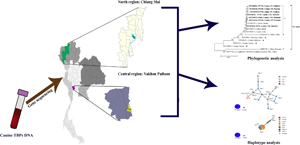Article contents
Molecular discrimination and genetic diversity of three common tick-borne pathogens in dogs in Thailand
Published online by Cambridge University Press: 08 September 2021
Abstract

There was little information regarding the occurrence of canine vector-borne disease (CVBDs) in shelter dogs in Thailand. This work is the first report regarding a molecular method used to determine the occurrence and genetic diversity of three canine tick-borne pathogens (TBPs) (Hepatozoon canis, Anaplasma platys and Ehrlichia canis) in blood samples from 275 shelter dogs in the north and central areas of Thailand. The PCR results based on the 18S rRNA and 16S rRNA genes showed that 71 (25.82%) dogs were positive for at least a TBP. The overall occurrence rates of H. canis, A. platys and E. canis infections were 1.81, 16.36 and 7.64%, respectively. For the phylogenetic analysis, A. platys 16S rRNA gene was genetically diverse, while H. canis 18S rRNA and E. canis 16S rRNA genes were conserved. The haplotype diversity exhibited 12 and 2 haplotypes as well as 78 and 178 polymorphic sites of A. platys and E. canis 16S rRNA genes, respectively. Our findings could be used to improve the understanding of phylogeny and genetic diversity of TBP rRNA genes and used to ameliorate the diagnosis and control programmes for the diseases in Thailand.
Keywords
- Type
- Research Article
- Information
- Copyright
- Copyright © The Author(s), 2021. Published by Cambridge University Press
References
- 7
- Cited by



